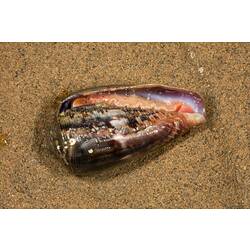General Description
Shell elongated conical shape with a short pointed end (spire) with rounded shoulders. Shell covered by a thin yellow-brown skin (periostracum). Shell colour underneath the periostracum is quite variable, but usually white-cream-grey with orange and dark brown markings underneath. Opening (aperture) elongated, extending almost the full length of the last whorl of the shell. Body red. Shell up to 5 cm long.
Biology
All Cone Shells are active hunters, using hard calcium darts armed with paralysing toxins to spear and kill their prey. Each species specialises on one food type, such as fish or worms, and each species has a distinct toxin. Anemone Cones feed mainly on polychaete worms. Cone toxins act very fast, allowing them to kill their often fast moving prey before it can get very far away. In humans, these toxins cause painful wounds, fainting and semi-paralysis; some tropical species have caused fatalities. The Anemone Cone is one of the few Cone species that live in southern Australian waters, but there may be multiple species in what is currently called Conus anemone. Eggs are laid in masses under rocks, to which they are attached. Juveniles are well-developed when they hatch and crawl away as miniature adults.
Distribution
Southern mainland Australia and Tasmania.
Habitat
Exposed and sheltered waters, usually in rock crevices, up to 130 m depth, most common up to 15 m depth.
More Information
-
Animal Type
-
Animal SubType
-
Brief Id
Orange and brown markings, opening along shell, short pointed tip.
-
Colours
Brown, Yellow
-
Habitats
-
Diet
Carnivore
-
Diet Categories
Invertebrates, Fish
-
Hazards
Toxic darts dangerous to humans.
-
Endemicity
-
Commercial
No
-
Conservation Statuses
CITES: Not listed, FFG Threatened List: Not listed, DSE Advisory List: Not listed, IUCN Red List: Least Concern
-
Depths
Shore (0-1 m), Shallow (1-30 m)
-
Water Column Locations
On or near seafloor
-
Taxon Name
-
Scientific Author
Lamarck, 1810
-
Common Name
Anemone Cone
-
Other Names
Cone Snail
-
Phylum
-
Subphylum
-
Superclass
-
Class
-
Subclass
-
Superorder
-
Order
-
Suborder
-
Infraorder
-
Superfamily
-
Family
-
Genus
-
Species Name
anemone



